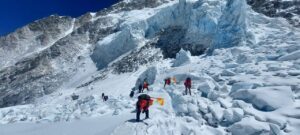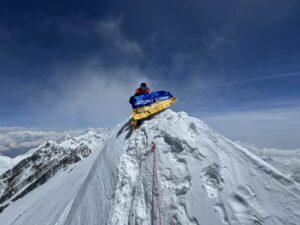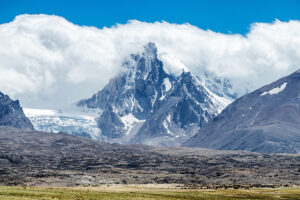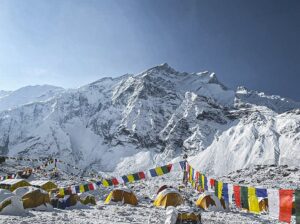Who is going to Annapurna this spring. Plus, a background to climbing the world’s deadliest 8,000’er.
Seven Summit Treks has a large team going for Annapurna, and regular readers will notice a few familiar faces from the recent expedition to winter K2, beginning with leader Chhang Dawa Sherpa.
Also joining SST: Waldemar Kowaleski, who abandoned K2 early because of a hernia, and Antonios Sykaris, who suffered from the lack of tents in Camp 3 during STT’s summit push on K2 last February. The Greek climber spent nearly an hour in the open at -50ºC, begging for refuge in one of the crowded tents, until Noel Hanna let him in. He returned to Base Camp with frostbitten toes and was evacuated by helicopter to a hospital in Skardu. Sykaris’s later account criticized SST’s messy organization, yet Sykaris is climbing with them again.
The guide team also includes winter K2 veteran Lakpa Dendi, who was with Atanas Skatov of Bulgaria when he sadly perished during his descent from Camp 3.
The Real Killer Mountain
Although Annapurna’s 8,091m make it one of the lower 8,000’ers, the climb is notoriously risky because of the seracs and especially the avalanches that sweep down the normal, north side route. It was the first 8,000m peak ever summited, in an epic effort by Maurice Herzog’s French team in 1950.
Success for these pioneers came at a high price, as nearly all of them suffered frostbite, especially summiters Herzog and Louis Lachenal, who lost all their toes. Herzog also lost most of his fingers. Since then, Annapurna has become an arena for many historic mountaineering epics, showcasing both excellence and drama. Both the North Side and wild, huge South Face saw game-changing climbs, extreme rescues, and was the demise of such great climbers as Anatoli Boukreev, Iñaki Ochoa de Olza, and Park Yong-Seok.
The French pioneers used no supplementary oxygen, and virtually all expeditions followed their style until very recently.
Annapurna has a whopping 32 percent summit/fatality rate, according to data from Eberhard Jurgalski of 8000ers.com. This means that for roughly every three who make it safely up and down Annapurna, one dies trying, making Annapurna famously “the most dangerous of all 8000ers”. While the summit/fatality rate is not a perfect metric, because it does not consider the number of climbers who don’t reach the summit, it gives an idea of the hazards.

Annapurna’s normal route. Photo: Ferran Latorre
The crux of the normal route is the long technical section below Camp 2, up an unstable glacier with hanging seracs that can come crashing down at any time. Satori Adventures, one of the outfitters that guide Annapurna, offers a no-nonsense description:
“Two hours from BC, the route starts with a steep 70˚ section. Here is the objective hazard area of falling seracs. From Camp I to Camp II, the climbing is slightly less steep but still tricky with great avalanche danger. Camp 2’s route to Camp 3 requires switchback navigation on the snowfield between the broken glacier’s seracs. The summit is on an exposed ridge.”
Some expeditions set up four camps, others three. The number and length of fixed sections also vary.
Until the last few years, Annapurna was a major challenge even for seasoned high-altitude climbers and a relatively low number actually summited. Even those aiming to complete all 14 8,000’ers often leave Annapurna till the very end.
In recent years, though, the number of summiters has increased dramatically, thanks to fully-serviced expeditions, bigger Sherpa teams that fix the route ahead of time, and massive use of supplementary O2, which allows faster (and therefore safer) climbs.
In 2019, 23 climbers received permits for Annapurna, and the number has increased significantly this year. Nepal’s Department of Tourism has announced permits for two expeditions, each with 15 non-Nepali members. SST has 15 foreign clients, although their male/female ratio does not quite fit with either of the two permits listed.

Climbing permits issued today, including two large expeditions to Annapurna I.
Many participants, including some with SST this year, climb Annapurna as part of a double-header. Immediately after, they go for Dhaulagiri, which is relatively close.
That is the case with Viridiana Álvarez of Mexico and Uta Ibrahini of Albania, who will join a team of female climbers on Dhaulagiri immediately after completing Annapurna. Poornima Shrestha, who was recently raising funds to climb Annapurna, has financed her climb by joining the guiding team.

Climbers head to Camp 3 on Annapurna. Photo: Chris Burke/Mountain Equipment






